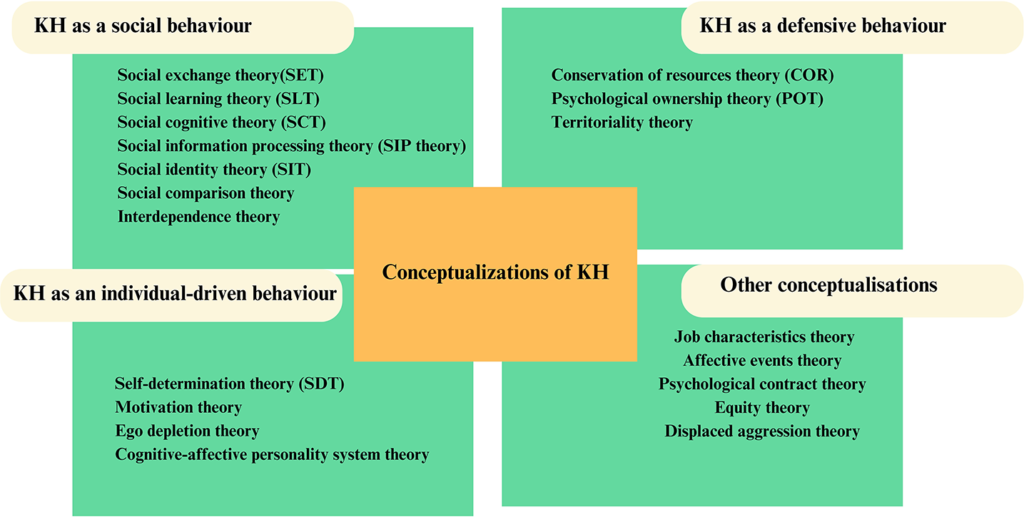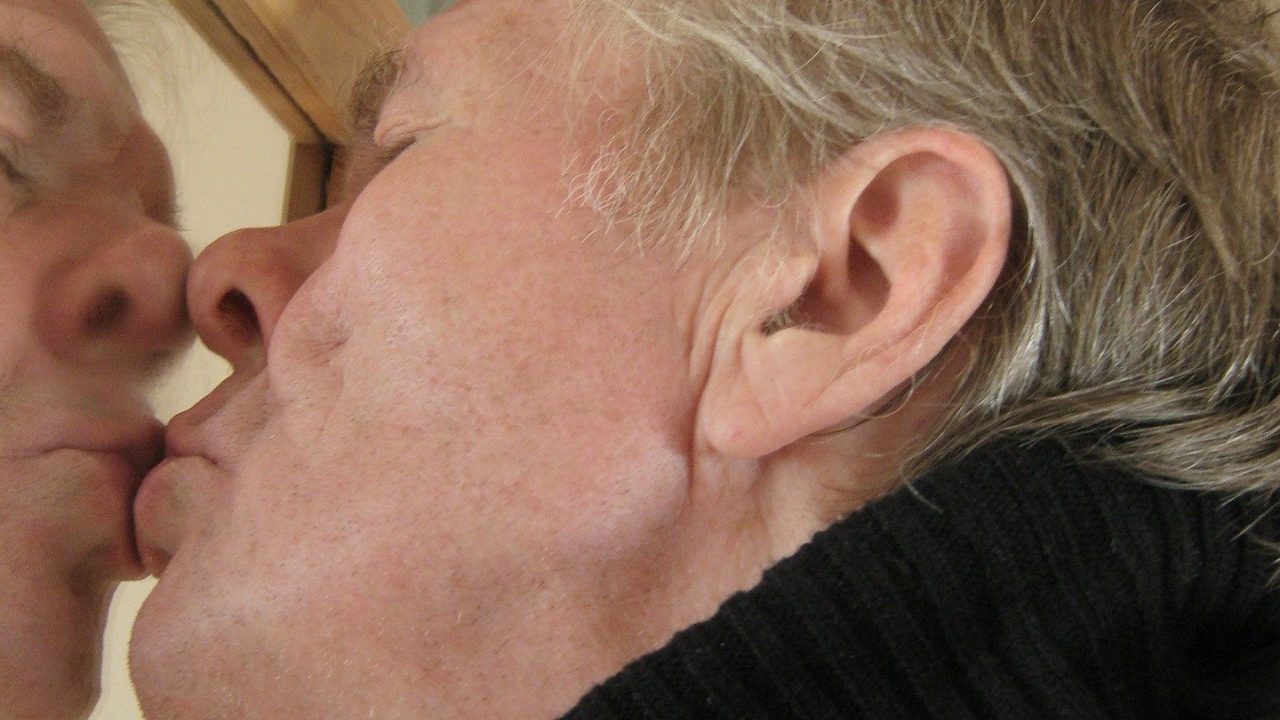
Which theories help us to understand knowledge hiding?
This article is part of a series on knowledge withholding, hiding, and hoarding.
Previous RealKM Magazine articles have explored various aspects of knowledge hiding, including (1) causes, impacts, and the ways forward, (2) the psychology behind knowledge hiding, and (3) workplace friendship and knowledge hiding. Other articles in the knowledge withholding, hiding, and hoarding series look at the differences between these behaviours.
New research1 from Talshyn Tokyzhanova and Susanne Durst and published in VINE Journal of Information and Knowledge Management Systems further adds to our understanding by examining the theoretical landscape of knowledge hiding using a theory-based systematic literature review.
To define knowledge hiding, Tokyzhanova and Durst draw on what has emerged as a consensus definition in previous research, which is that knowledge hiding is an intentional attempt by an individual to withhold or conceal task information, ideas, and know-how that another person has requested. Knowledge hiding is considered as a counter-productive knowledge behaviour in organisations, but is not necessarily intended to harm a person or an organisation. Rather, it is a response to a specific situation. Knowledge hiders may pretend that they do not possess the knowledge that is requested (playing dumb), provide incomplete or incorrect information with the promise of complete information in the future (evasive hiding), or explain failing to provide information or blame another party (rationalised hiding).
From the results of their review, Tokyzhanova and Durst report on:
- Theories for understanding knowledge hiding.
- Conceptualisations of knowledge hiding.
- Dominating assumptions underpinning knowledge hiding research.
1. Theories for understanding knowledge hiding
Tokyzhanova and Durst analysed 170 scientific papers, revealing 86 distinct theories:
- Social exchange theory (SET) is the most frequently used theory, with 49 articles. This theory serves as a basis for understanding the reciprocal nature of social interactions, possibly explaining why people may engage in knowledge hiding to balance social reciprocity.
- Conservation of resources (COR) theory closely follows, which appears in 38 articles. This theory contributes by framing knowledge as a finite resource that individuals might strive to conserve, manifesting knowledge hiding tendencies.
- Social learning theory (SLT) is another theoretical lens used in 13 studies, which offers insights into how knowledge hiding behaviours may be socially learned and perpetuated within organisational settings.
- Psychological ownership theory (POT) has been invoked in ten articles, suggesting that a sense of ownership over knowledge can significantly influence an individual’s decision to withhold it.
- Social cognitive theory (SCT), featured in nine articles, explores the cognitive processes that could mediate knowledge hiding within social contexts.
- Furthermore, social comparison theory and self-determination theory (SDT), each employed in seven articles, provide avenues for investigating the emotional and motivational aspects underpinning knowledge hiding.
- Social information processing (SIP) theory and social identity theory (SIT) are less frequent; they have been used in six and five articles, respectively. These theories examine how social contexts shape knowledge-processing behaviours and how in-group versus out-group dynamics might contribute to knowledge hiding.
2. Conceptualisations of knowledge hiding
Tokyzhanova and Durst further identify the four conceptualisations of knowledge hiding that emerged from the data, as shown in Figure 1 and explained after the figure.

Knowledge hiding as a social behaviour
The majority of articles view knowledge hiding as social behaviour characterised by a reciprocal interchange where the causes or effects of an action are influenced by or directly involve the behaviour of others. This exploration draws heavily on the reciprocity highlighted in social exchange theory (SET), where relationships among colleagues are built based on interpersonal transactions in the workplace.
For instance, positive leader/supervisor behaviour, e.g. leader–member exchange, supervisor support, humble leadership, and empowering leadership motivates followers/supervisees to reciprocate positive behaviour by decreasing their knowledge hiding until a perceived balance of exchange is reached. Employers who invest more in their employees’ development by offering superior high-performance work systems, promoting shared goals, and organisational support encourage more positive behaviours and lower knowledge hiding climate.
Interactions with co-workers are also crucial, e.g. team-member exchange and perceived co-worker support are negatively related to knowledge hiding. However, individuals may reciprocate not only positive actions but also negative ones. Following the SET, reviewed research suggests that negative leader/supervisor behaviour, such as exploitative leadership and abusive supervision, encourage followers to negatively reciprocate by decreasing their knowledge hiding behaviour. When employees experience uncivil treatment or bullying, the social exchange process assumes that both parties further exchange in a mutually hostile manner by exhibiting negative behaviour, such as knowledge hiding.
The second conceptualisation in this category assumes that knowledge hiding is a learnt behaviour from the social environment, drawing from social learning theory (SLT), social cognitive theory (SCT), and social information processing (SIP) theory. According to SLT, the behaviour of individuals within an organisation, including practices around knowledge hiding, is largely learned through observation of others, particularly those in leadership positions. For instance, ethical leadership and empowering leadership are modelled as exemplary behaviours, promoting a culture of openness and knowledge sharing. Conversely, witnessing knowledge withholding by supervisors or engaging in self-serving leadership can signal to employees that knowledge hiding is an acceptable, or even strategic, behaviour under certain conditions.
Building upon SLT, SCT emphasises the reciprocal relationship and interaction among the environment, personal characteristics and behaviours. Environmental cues, such as a mastery climate, can positively impact perceived status within an organisation, whereas corporate hypocrisy can affect moral identity, both of which can then affect employee knowledge hiding. Negative workplace behaviours, such as leader knowledge hiding, perception of organisational politics, and negative workplace gossip initiate moral disengagement by lowering the moral self-standard and increasing knowledge hiding.
SIP theory further elucidates the process by which individuals interpret and respond to the social cues in their environment, influencing their knowledge hiding behaviours. Leaders and those with high levels of power influence employees’ perceptions of the workplace. If employees perceive their supervisors to practise self-serving leadership, treat them unfairly in a team setting, or withhold knowledge, they may interpret this as a negative signal and engage in knowledge hiding behaviours. Conversely, when employees feel valued and appreciated through servant leadership, supervisor support, and appropriate HR practices, they may be less likely to engage in knowledge hiding behaviours.
The third conceptualisation in this category refers to the impact of the social environment on self-concept. Social identity theory (SIT) unveils that employees with a strong identification with their team or organisation display a diminished inclination towards knowledge hiding. In cases where employees disagree with prevailing practices, such as organisational injustice, they may intentionally withhold requested knowledge from their colleagues to assert the distinctiveness of their identity.
This discourse is further enriched by social comparison theory and relative deprivation theory, which suggest that employees’ perceptions of their qualifications and relative standing within the organisation can catalyse knowledge hiding. The differentiation in leader–member relationships, traversing the spectrum from empowering to abusive supervision, shapes interpersonal dynamics and fosters environments ripe for knowledge hiding as individuals navigate the treacherous waters of “self versus others” comparisons. This differentiation fosters negative “self versus others” comparisons, which results in engaging in acts such as knowledge hiding.
Knowledge hiding as a defensive behaviour
Conservation of resources (COR) theory is the second most frequently used theory, used in 38 articles. This research shows that when employees are subjected to abusive and unethical leadership, they can experience emotional exhaustion, psychological unsafety, a lack of respect, feel insecure about their job, and have relational identification issues and psychological distress in the workplace. The COR theory suggests this can trigger self-protective behaviours like knowledge hiding to conserve resources.
Targets who experience social stressors such as negative workplace gossip, workplace ostracism, and bullying may engage in knowledge hiding to protect their remaining resources. Similarly, knowledge hiding can also serve as a defence mechanism against emotional resource depletion and relational conflicts. Other factors like organisational justice, dysfunctional organisational politics, excessive time pressure, and significant work pressures may also promote knowledge hiding as a resource conservation behaviour. However, fear of reprisal or task delay may deter knowledge hiding despite work overload.
Psychological ownership theory (POT) postulates that individuals are possessive towards something they consider their own. This sense of ownership is particularly strong when it comes to knowledge. Accordingly, they will proactively establish a protection mechanism to hide that knowledge. However, if employees view the organisation as a target of ownership, they may perceive that the knowledge is common to the organisation. This could weaken the knowledge hiding behaviours in the organisation.
Territoriality theory suggests that an individual’s psychological ownership of an object can lead them to treat it as their own territory, resulting in a desire to defend and protect it. From such a viewpoint, knowledge hiding is a behavioural expression of territoriality that motivates the holder to engage in territorial guarding to maintain their advantageous position.
Knowledge hiding as an individual-driven behaviour
This category, representing the smaller subset of the literature, focuses on knowledge hiding as behaviour driven by individual factors. At the core of this exploration is self-determination theory (SDT), which frames knowledge hiding within the context of unmet psychological needs. SDT suggests that when individuals feel disconnected from their work, dissatisfied with their performance, or deprived of job autonomy, they might resort to knowledge hiding as a means to navigate these deficits.
Similarly, motivation theory delineates the dual role of motivation in shaping knowledge hiding. It posits that while financial incentives might inadvertently encourage knowledge hiding by fostering controlled motivation, intrinsic motivations tied to social aspects of work could deter such behaviour.
Complementing the insights from SDT, the theory of planned behaviour provides a basis for understanding knowledge hiding through the lenses of attitudes, subjective norms and perceived behavioural control. This approach underscores the complexity of knowledge hiding as influenced by individual attitudes and the normative pressures of the organisational environment, explored across varied settings such as international entrepreneurial firms and R&D teams.
The narrative then shifts to the ego depletion theory, which posits that self-control and willpower draw upon a limited pool of mental resources that can be depleted over time. When individuals face demanding or stressful situations, they consume these resources and their capacity for self-control diminishes. This potentially leads to behaviours they might otherwise resist, such as knowledge hiding.
Continuing on the internal state of the individual, the cognitive-affective personality system theory shows how individuals’ unique cognitive and emotional patterns interact with specific situations to produce consistent behaviours over time. Building upon this perspective, the cognitive pathways that exist between time pressure, negative workplace gossip, workplace bullying, and knowledge hiding are studied.
Other conceptualisations
Job characteristics theory suggests that job complexity and task interdependence can motivate employees to hide knowledge, impacting organisational outcomes. Affective events theory indicates that workplace events trigger emotions that mediate behaviours like knowledge hiding, where positive events may reduce knowledge hiding, whereas negative events increase it. Contextual theory highlights how organisational settings and factors such as HR systems and relational climates moderate knowledge hiding’s occurrence and its antecedents. Psychological contract theory posits that breaches in perceived organisational obligations can lead to knowledge hiding, influenced by individual personality traits and work motivations. Finally, equity theory explains how imbalances in perceived inputs and outcomes lead to negative emotions and increased knowledge hiding, with equity sensitivity influencing individual responses to these imbalances.
3. Dominating assumptions underpinning knowledge hiding research
Tokyzhanova and Durst also delve into the dominant assumptions underpinning knowledge hiding research. By examining how assumptions linked to various theoretical lenses influence the conceptualisation of knowledge hiding, they aim to provide a clearer understanding of the foundational beliefs guiding this field.
Knowledge hiding is negative
One of the most prevailing assumptions in the reviewed papers is that knowledge hiding is detrimental to individuals and organisations. This perspective is bolstered by a substantial body of research indicating that knowledge hiding negatively affects individual in-role performance, organisational citizenship behaviour, employee identification, creativity, and innovative behaviour.
Knowledge hiding is objective
knowledge hiding is generally recognised as a behaviour identifiable through specific actions within organisational settings. This perspective treats knowledge hiding as a phenomenon that can be quantified and observed systematically. Commonly employed theories such as SET, COR theory and SDT suggest that rational, measurable decisions in diverse organisational contexts drive knowledge hiding.
Knowledge hiding is immediate reactive
knowledge hiding is predominantly assumed as a reactive behaviour, frequently informed by social-based and defensive mode-based theories. The reliance on these theories underscores a prevailing assumption within knowledge hiding research: hiding knowledge is often an immediate, reflexive action triggered in response to various social stimuli or stressors.
Knowledge hiding is mostly relational
knowledge hiding is frequently conceived as an informal, relational dynamic that unfolds within the interpersonal spaces of organisational life. At its core, this view acknowledges that the quality of interpersonal relationships and the social climate within the organisation significantly influence the decision to hide or share knowledge.
Article source: ©Tokyzhanova & Durst 2024, CC BY 4.0.
Header image source: Robin Higgins on Pixabay.
References:
- Tokyzhanova, T., & Durst, S. (2024). Insights into the use of theories in knowledge hiding studies: a systematic review. VINE Journal of Information and Knowledge Management Systems. http://dx.doi.org/10.1108/VJIKMS-11-2023-0303. ↩





